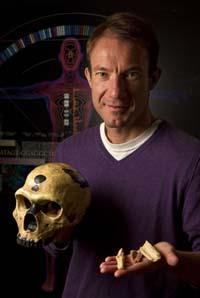The Basques, heirs of the Neanderthals?
The comment is signed by a person named Jacques Lerin and the article containing the comment is entitled: Neanderthals may have interbred with humans, that is, it is possible that Neanderthal and Homo sapiens have crossed. Jacques Lerin wonders if the Basques are the result of this hybridization.

According to recent studies, H. sapiens crossed with H. neanderthalensis. (Photo: Jim MacKenzie/UC Santa Cruz)
Aside from that Mr. Lerín believes that it is half or totally corrupt, it is not the first time that the hypothesis that both species crossed each other. The idea is not at all slippery. They had time and opportunity: H. sapiens separated about 400,000 years ago and the Neanderthals disappeared 30,000 years ago.
Therefore, scientific articles favorable to this hypothesis have been published on several occasions. The present, published in Nature, is a study by the genetics of the University of New Mexico. It has been presented at the annual congress of the Physical Anthropology Association of the United States, where the authors have stated that "the Neanderthals did not completely disappear".
To reach this conclusion, the genomes of 1,983 people from all continents and 99 populations have been analyzed. Specifically, they have focused on microsatellites, parts of the genome as the fingerprints of people. Taking into account the differences between microsatellites, they have made an evolutionary tree and realized something they did not expect. The best hypothesis to explain the differences between microsatellites is that the species H. sapiens crossed twice with older species, H. neanderthalensis and H. heidelbergensis.
The researchers have taken into account the frequency with which genetic mutations and the data obtained through the fossils are produced. Thus, it is estimated that H. sapiens crossed with the Neanderthals on two occasions outside Africa, 60,000 ago in the east of the Mediterranean and 45,000 years ago in East Asia.
Hybridization test
And this same Thursday the scientific journal Science has published another research that reinforces the hypothesis of the crossing. In fact, a group of international researchers has decoded the genome of a Neanderthal and compared it to the genomes of five current people of different origins. The result is consistent with New Mexico researchers: it is very likely that both species have crossed.
Both investigations have aroused great interest among experts. In fact, most studies in favor of the crossing were based on morphological indications, that is, on the shape of the bones. Now, thanks to genetics, they have been able to confirm or cancel many aspects that were previously unclear.
In addition, thanks to other types of research, experts are increasingly familiar with Neandertals and, at the same time, is changing the image that people had of them, demonstrating that they were more advanced and sophisticated than previously thought. An expert in human and environmental sciences, Steven Mithen, for example, wrote the book The singing neanderthals in 2004. It is now translated into Basque in the Klasikoak collection. A good opportunity for anyone who wants to know more about Neanderthals.
Published in Gara
Buletina
Bidali zure helbide elektronikoa eta jaso asteroko buletina zure sarrera-ontzian











